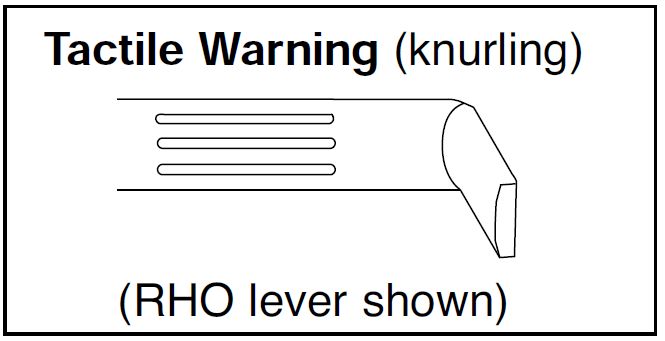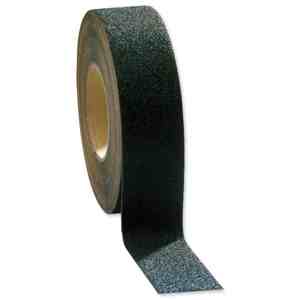Some questions about tactile warning on door hardware have come up recently, so I’ve updated this Decoded article.
This Decoded article was published in Door Security + Safety
.

Question: Am I required by code to provide a tactile warning on certain doors in my facility? If tactile warning is required, are stair doors included? What types of materials are allowed for tactile warning on doors?
 Answer: The 1986 edition of ICC A117.1 (which was then called Providing Accessibility and Usability for Physically Handicapped People – now called Accessible and Usable Buildings and Facilities) included a requirement for tactile warnings on doors leading to hazardous areas. The intent was to provide a warning to a person with a visual impairment that the door leads to a room where they could encounter something dangerous. Examples of hazardous rooms included loading docks, boiler rooms, and stages – other standards include electrical and mechanical rooms on the list of examples.
Answer: The 1986 edition of ICC A117.1 (which was then called Providing Accessibility and Usability for Physically Handicapped People – now called Accessible and Usable Buildings and Facilities) included a requirement for tactile warnings on doors leading to hazardous areas. The intent was to provide a warning to a person with a visual impairment that the door leads to a room where they could encounter something dangerous. Examples of hazardous rooms included loading docks, boiler rooms, and stages – other standards include electrical and mechanical rooms on the list of examples.
While I have seen some state standards (ex: Massachusetts) which still contain a requirement for tactile warning on doors leading to hazardous areas, there has been no requirement for this in ICC/ANSI A117.1 since 1992. The Uniform Federal Accessibility Standards (UFAS) do contain a requirement for tactile warning, but this standard has for the most part been replaced by the 2010 ADA Standards for Accessible Design. The 1991, 1994, and 2010 ADA standards do not include a requirement for tactile warning on doors leading to hazardous areas – the section heading is “reserved” in the earlier editions and does not appear at all in the 2010 edition. So the jurisdictions that require tactile warning on doors to hazardous areas are quite limited.
 Where a tactile warning is required for door hardware, typically either knurled levers, raised or recessed “dots”, or an abrasive material is acceptable. I have often seen abrasive tape applied to the back of a lever to meet the requirements in my home state of Massachusetts. Because the types of rooms considered hazardous are not specifically defined, it’s difficult to know where the Authority Having Jurisdiction will require a tactile warning, and abrasive tape can be a good solution in this case.
Where a tactile warning is required for door hardware, typically either knurled levers, raised or recessed “dots”, or an abrasive material is acceptable. I have often seen abrasive tape applied to the back of a lever to meet the requirements in my home state of Massachusetts. Because the types of rooms considered hazardous are not specifically defined, it’s difficult to know where the Authority Having Jurisdiction will require a tactile warning, and abrasive tape can be a good solution in this case.
The question of whether or not to provide knurling or an abrasive coating on stair doors is an interesting one. The thought behind this practice is that someone who is visually impaired could fall down the stairs, but my concern would be that the person might not enter the exit stair because they believe that the door leads to a hazardous room. This would be especially true if the stair door was equipped with a lever handle. For stair doors with fire exit hardware, years ago I heard of some AHJs requiring abrasive tape as a tactile warning on the touchpad. Again, I think this could discourage someone from using the exit. I think a much better solution for those jurisdictions would be tactile lettering and/or braille on the touchpad of the exit device, indicating that the door leads to a stair. The tactile signage now required for stair doors will also help to prevent someone from unknowingly entering a stair.
Some of the confusion about tactile warning on stair doors may come from sections from the standards addressing “Detectable Warnings.” The original ADA guidelines include two reserved sections with the headings “Detectable Warnings at Stairs” and “Detectable Warnings on Doors to Hazardous Areas.” This could lead to the belief that detectable warnings are the same (knurled hardware) for both applications.
 Detectable warnings are defined by the 2009 and 2017 editions of A117.1 and the 2010 edition of ADA-ABA as “A standardized surface feature built in or applied to walking surfaces or other elements to warn of hazards on a circulation path.” They are raised domes in the walking surface, and they’re typically only required at transportation platform edges and similar changes in level. In standards that require detectable warnings for stairs, there is typically an exception for dwelling units as well as for enclosed stairs, so the raised domes in the flooring would typically apply to open stairs with no doors.
Detectable warnings are defined by the 2009 and 2017 editions of A117.1 and the 2010 edition of ADA-ABA as “A standardized surface feature built in or applied to walking surfaces or other elements to warn of hazards on a circulation path.” They are raised domes in the walking surface, and they’re typically only required at transportation platform edges and similar changes in level. In standards that require detectable warnings for stairs, there is typically an exception for dwelling units as well as for enclosed stairs, so the raised domes in the flooring would typically apply to open stairs with no doors.
To summarize:
- The prevalent accessibility standards currently used in the U.S. (ICC A117.1 and the ADA Standards for Accessible Design) do not require tactile warning on doors leading to hazardous areas.
- The last time either of these standards did include this requirement was the 1986 edition of ICC A117.1.
- These standards do not include a requirement for hardware on stair doors to have a tactile warning.
- Applying a tactile warning to stair doors could prevent a person with a visual impairment from accessing the exit.
- “Detectable Warnings” required by some codes and standards are typically raised domes in the floor surface.
- Some state or local standards may require tactile warnings on certain doors.
- Where tactile warnings are required, knurling or an abrasive tape/coating should be acceptable unless the requirements or the AHJ require a specific method of creating the tactile warning.
Here are excerpts from the standards regarding tactile warning:
1986 edition of A117.1 (this section was removed in the 1992 edition):
4.27.3* Tactile Warnings on Doors to Hazardous Areas. Doors that lead to areas that might prove dangerous to a blind person (for example, doors to loading platforms, boiler rooms, stages, and the like) shall be made identifiable to the touch by a textured surface on the door handle, knob, pull, or other operating hardware. This textured surface may be made by knurling or roughening or by a material applied to the contact surface. Such textured surfaces shall not be provided for emergency exit doors or any doors other than those to hazardous areas.
4.27.4 Detectable Warnings at Stairs. All stairs, except those in dwelling units, in enclosed stair towers, or set to the side of the path of travel shall have a detectable warning at the top of stair runs (see Fig. 41).
1991 and 1994 Editions of the Americans With Disabilities Act (ADA) Guidelines:
4.29.3 Detectable Warnings on Doors To Hazardous Areas. (Reserved).
4.29.4 Detectable Warnings at Stairs. (Reserved).
Uniform Federal Accessibility Standard (UFAS):
Note: This standard has very limited usage currently, but the text is included for historical reference.
4.29.3* TACTILE WARNINGS ON DOORS TO HAZARDOUS AREAS. Doors that lead to areas that might prove dangerous to a blind person (for example, doors to loading platforms, boiler rooms, stages, and the like) shall be made identifiable to the touch by a textured surface on the door handle, knob, pull or other operating hardware. This textured surface may be made by knurling or roughing or by a material applied to the contact surface. Such textured surfaces shall not be provided for emergency exit doors or any doors other than those to hazardous areas.
A4.29.3 TACTILE WARNINGS ON DOORS TO HAZARDOUS AREAS. Tactile signals for hand reception are useful if it is certain that the signals will be touched.
4.29.4 TACTILE WARNINGS AT STAIRS. (Reserved).
Massachusetts 521 CMR Architectural Access Board Regulations:
26.11.4 Special hardware: Doors opening into hazardous areas shall have door-opening hardware which is knurled or has a roughened surface to give tactile warning to persons with visual impairments. Hazardous areas shall include but not be limited to loading platforms, boiler rooms, and electrical equipment rooms.
You need to login or register to bookmark/favorite this content.









This article provides valuable insights into tactile warnings for accessibility, especially regarding doors to hazardous areas and staircases. The discussion on potential drawbacks of abrasive tape on stair doors is particularly thought-provoking.
I haven’t seen the tactile requirement in the specification for years. Mostly building will use Dome Flooring instead
I worked on a medical office building last year, the stair wells both front and rear (more for staff use) both had swinging guards at the down side of the stairs, The rear I could see, as there was a outward swinging door on a 5 foot landing for staff from first floor to basement/2nd floor and an exit to exterior ground level on the end of this landing.
The front stairs, to basement (guard) and 2nd floor were directly across from the elevators the exit door to ground level was out swinging, as it should have been,
Thanks Bob!
Those guards are usually to keep people from passing the exit discharge and continuing down into the lower levels.
– Lori